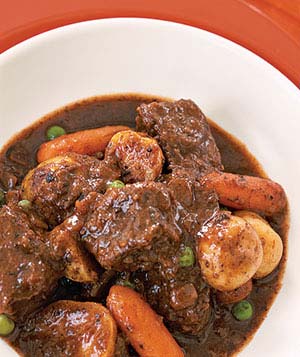My Best-Ever Beef Stew
I took the ultimate one-pot comfort food and slashed the fat, calories and sodium.

Beef stew sounds good on paper: a warm, comforting pot of meat and root vegetables, all slow cooked and infused with earthy flavor. It’s the kind of dish you’re more likely to eat at the kitchen table than order at a restaurant. Then why is something so nourishing and homey so bad for your waistline? To find out, I combed through traditional recipes and identified the factors that clan often make this dish artery clogging rather than wholesome.
Meat matters
Walk up to any meat counter and you’re likely to see “beef for stew” or something similar. Meat carrying this label can come from any part of the cow, but it’s typically chuck or round. Both need long, slow cooking to break down the connective tissue that can make them tough. Additionally, there are many cuts within these two categories, some of which are fattier than others. Rule of thumb: Chuck is typically higher in fat.
Fortunately, there is a way to bypass all this confusion. Skip the stew meat in favor of a top round roast and chop it exactly the way you’d like to at home. It’s one of the leanest parts of the round and full of beefy flavor.
Since it contains less fat, however, ti is important to keep the stew at a low simmer – never let it boil, as this can lead to toughness. When I used top round, I was amazed at how little fat there was to skim off the stew.
Details make a difference
Next I started to notice other ways that this classic recipe can go astray. Does it require a cup (or three) of red wine? Not when you can create depth of flavor with balsamic vinegar and tomato paste. Does it need salty broth, sodium-filled additions such as Worcestershire sauce and finally a heaping scoop of salt? Nope. Low-sodium broth, dried herbs and spices are sufficient and do not hide the flavor of your main ingredients. Is a huge helping of potatoes absolutely necessary? I would rather replace some of the spuds with earthy, low-calorie celery root and add bright green peas for a pop of color and extra taste.
The final touch, which ups the flavor ante and gives the stew my own personal twist, is balsamic-sautéed portobellos. These meaty mushrooms add another layer of savory, brawny flavor without pushing calories and fat through the roof. That’s the kind of classic home cooking I can feel good about!
Get to know your root vegetables
I opted for potatoes, carrots and celery root in this stew, but you can experiment with any root vegetable (just keep the total quantity of chopped root veggies to around 3 ½ cups). This guide provides simmer times to help you determine when to add them to your stew.
Rutabagas – firm, creamy texture; slightly bitter flavor that mellow when cooked. Use It: Peel and cut into ¾ -inch chunk; simmer for 20 to 25 minutes.
Parsnips – similar in texture to carrots, but very sweet when cooked. Use It: Peela dn cut into ½ -inch pieces; simmer for 50 to 60 minutes.
Golden beets – unlike red beets, this slightly milder variety won’t tint other ingredients. Use It: Trim root and stem ends, peel and cut into ¾ -inch chunks; simmer for 20 to 25 minutes.
Sweet potatoes – sweet and firm, yet relatively quick-cooking. Use It: Peel and cut into ¾ -inch chunks; simmer for 20 to 25 minutes.
Turnips – crisp, radish-like texture, but with less peppery bite. Use It: Peel and cut into ¾ -inch chunks; simmer for 15 to 20 minutes or until just tender – overcooking decreases sweetness.
Parsley root – fibrous, carrot-shaped roots; full of parsley flavor. Use It: Peel and cut into ½ -inch pieces; simmer for 50 to 60 minutes.
Source: CleanEatingMag

